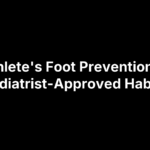That sudden buckle on a sidewalk or court doesn’t have to become your ankle’s life story. By the time you finish this guide you’ll have 15 physical-therapist approved exercises that tighten the ligaments, sharpen balance, and slash the odds of another sprain—all without a gym membership.
Weak peroneal muscles, leftover laxity from past sprains, poor proprioception, or hypermobile joints can leave each step feeling uncertain. A targeted mix of strength, mobility, and balance drills—done three or four times a week—teaches your ankles to read the ground and react before trouble strikes. Warm up first with five-to-seven minutes of marching, heel walks, and ankle circles; train barefoot on a firm floor before graduating to foam pads or a balance board. Stop if you feel anything sharper than a mild muscle burn, and check in with a podiatrist if swelling or pain lingers. We’ll break down every move step-by-step, flagging common mistakes, easy tweaks, and tougher progressions, then wrap up with a screenshot-ready cheat-sheet for reference. Ready to steady up your stride?
1. Single-Leg Balance (Barefoot)
Don’t be fooled by its simplicity—standing on one foot lights up the tiny postural muscles that guard your ankle 24/7. Practicing barefoot lets your toes spread and grip, giving the brain clearer sensory data to work with before you ever add bands or boards.
How to Perform It Safely
- Stand tall, feet hip-width.
- Shift weight to your right foot, knee softly bent, hips level.
- Lift the left foot an inch or two; keep eyes forward, core engaged.
- Hold 30 seconds, breathing steadily.
- Switch sides. Complete 3 rounds.
Stability Muscles Worked & Why It Helps
- Intrinsic foot muscles keep the arch from collapsing.
- Peroneals and posterior tibialis react to micro-wobbles, preventing rolls.
- Glute medius holds the pelvis level, reducing compensatory torque on the ankle.
Progressions & Regressions
- Easier: fingertip support on a wall or chair.
- Harder: close eyes, stand on a foam pad, or add mini single-leg squats.
Aim to perform the drill three times a week without letting the lifted foot touch down.
2. Alphabet Ankle Tracing
Think of this as cursive handwriting for your joint. Tracing the alphabet forces the ankle to explore every nook and cranny of its range, a perfect low-load warm-up or rehab drill that pairs well with the other ankle stability exercises in this list.
How to Perform It Safely
- Sit in a chair—or lie on your back if post-injury—with the working leg extended and heel hovering off the floor.
- Leading with the big toe, “write” the letters A through Z in the air.
- Keep the shin still; all motion comes from the ankle.
Mobility & Neuromuscular Benefits
- Moves the joint through all planes, spreading synovial fluid to nourish cartilage.
- Activates anterior tibialis, peroneals, and deep stabilizers that often sleep after a sprain.
Programming Tips
- One complete alphabet equals one set; perform 2–3 sets per side daily.
- Sneak it in during desk breaks or TV time—no equipment, no excuses.
3. Calf Raises
Calf raises may be old-school, but they’re still the quickest way to armor the back of the lower leg. Each deliberate lift loads the gastrocnemius, soleus, and Achilles tendon so they can decelerate landings and keep the ankle centered during every stride.
Step-by-Step Form
- Stand hip-width with feet parallel, weight evenly on the balls of your feet.
- Squeeze your glutes and core, then rise straight up without letting ankles roll out.
- Pause one second at the top for maximal calf engagement.
- Lower in three controlled seconds until heels kiss the floor.
Do 2–3 sets of 12–15 reps.
Why Strong Calves Protect Ankles
Robust plantarflexion strength absorbs ground forces before they reach the ligaments, reduces wobble during quick direction changes, and supports the arch so it doesn’t collapse under load.
Variations for All Levels
- Start bilateral on flat ground
- Progress to single-leg or add a dumbbell in the opposite hand
- Advance further by using a step for a full stretch at the bottom
4. Tibialis (Toe) Raises
Your calves do plenty of work, but the muscles on the front of the shin—especially the anterior tibialis—often get ignored. Toe raises balance the strength equation so your ankle can control both upward and downward motion, a must for runners who over-supinate or anyone rehabbing chronic sprains.
Proper Technique
- Lean back against a wall, heels 6–8 in from the baseboard, knees straight.
- Lift the balls of your feet toward your shins as high as possible.
- Pause one second, then lower slowly for a three-count.
Aim for 2–3 sets of 15 reps.
Muscles Targeted
- Anterior tibialis
- Extensor digitorum longus
- Small stabilizers along the front of the ankle
Progressions & Common Errors
- Level up with a mini-loop band around the forefoot or by performing single-leg reps.
- Keep knees locked; bending them shifts load away from the tibialis.
- Avoid rocking hips—movement should come only from the ankle.
5. Resistance-Band Dorsiflexion
Think of dorsiflexion as your ankle’s braking system. Strengthening it with a simple loop band complements the calf-dominant moves above and rounds out your ankle stability exercises toolkit.
Setup & Execution
Loop a light-to-medium resistance band around the ball of your foot and anchor the other end to a sturdy sofa leg. Sit on the floor, knee bent to 90°, heel resting on the ground so only your ankle moves.
Key Coaching Cues
Flex the ankle, drawing toes toward shin for two seconds; avoid lifting the thigh or flexing the hip. Move smoothly, stop shy of pain, and control the band’s return.
Reps, Sets, Tempo
Perform 2–3 sets of 12–15 reps per ankle. Use a 2-0-3 tempo—two-second lift, zero pause, three-second eccentric—to nourish tendons and sharpen motor control.
6. Resistance-Band Plantarflexion
Band-assisted plantarflexion grooves a strong, symmetrical push-off—exactly what you need for sprint starts, stairs, and every athletic cut. It pairs perfectly with the dorsiflexion drill to keep your ankle strength balanced front to back.
Step-by-Step
- Sit tall with legs extended, knee relaxed.
- Loop the band around the ball of your foot; hold both ends taut in your hands.
- Point the toes away, pressing through the band for a two-count.
- Pause briefly, then return slowly in three seconds.
- Perform 2–3 sets of 12–15 reps per side.
Stability Payoff
Plantarflexion strengthens the gastrocnemius-soleus-Achilles complex, boosting shock absorption and keeping the ankle centered during jumps and sudden stops.
Make It Harder
Double the band, add a seated calf raise immediately after each rep, or progress to single-leg standing presses on a step for extra range.
7. Resistance-Band Inversion
Most ankle sprains happen when the foot rolls outward; training inversion—the motion that pulls the sole inward—fortifies the tissues that stop that roll before it starts. Keep the action slow and controlled so the stabilizers fire, not the bigger hip muscles.
Setup
- Attach a light band to a stable object on your right side.
- Sit with legs extended; loop the other end around the inside of your right forefoot.
- Cross the left leg over for leverage, toes pointing up; tension should pull your foot outward.
Ligament & Muscle Focus
- Posterior tibialis
- Flexor digitorum longus
- Medial ankle capsule and deltoid ligament
Form Tips
- Move only at the ankle—imagine your shin is cemented in place.
- Pull the sole toward midline for two seconds; return in three.
- Keep reps smooth (12–15), 2–3 sets per side, stopping if you feel pinching on the outer ankle.
8. Resistance-Band Eversion
Protecting the outer ankle means strengthening the peroneal muscles that pull your foot outward—an action called eversion. A simple loop band lets you isolate them without fancy gear or weight-bearing stress.
Execution Basics
- Sit legs straight, band around inside of left foot, anchored to the right side.
- Keep knee still; sweep the forefoot outward.
- Pause, return in three seconds. Do 12–15 reps, 2–3 sets each foot.
Why It Matters
- Peroneus longus and brevis are first responders against common lateral sprains.
- Strong eversion keeps the subtalar joint centered during side cuts, descents, and trail missteps.
Progressions
- Bent-knee position to bias peroneus brevis.
- Stand and perform banded monster walks or single-leg hip hinges while holding eversion.
9. Heel-to-Toe Walking (Tandem Walk)
Heel-to-toe walking mimics a tight-rope stroll, forcing ankles, arches, knees, and hips to sync for a rock-solid gait and quick reflexes on uneven ground.
How to Do It
- Stand tall, arms out for balance.
- Place the right heel directly in front of the left toes and begin walking forward in a straight line.
- Take 20–30 slow steps, eyes forward, keeping each foot in contact for a split second before lifting the back leg.
Balance & Gait Benefits
- Challenges mid-stance stability and strengthens intrinsic foot muscles.
- Sharpens proprioception along the lateral ankle ligaments that frequently fail during slips.
- Reinforces a smooth heel-strike-to-toe-off pattern, translating to more efficient running and everyday walking.
Upgrades
- Close your eyes or turn the head side-to-side while walking.
- Reverse direction for backward tandem steps.
- Carry a light kettlebell overhead to add core demand without stressing the ankle joint.
10. Star Excursion Balance Reach
The Star Excursion Balance Reach (SEBR) turns single-leg standing into a 360-degree challenge that forces your ankle, knee, and hip to coordinate under moving load. Because the stance foot must stabilize while the other leg “maps” a star on the floor, this drill blends strength, proprioception, and mobility—making it one of the most respected ankle stability exercises in sports rehab.
Step-by-Step
- Stand on your right leg in the center of an imaginary star.
- Keeping hips level, reach your left foot forward, then return to center.
- Continue reaching to the front-left, side-left, back-left, and the remaining four points (8 total).
- Switch legs; complete 2–3 rounds per side.
Evidence-Based Perks
- Research links SEBR to improved dynamic balance and fewer ankle re-sprains in athletes.
- Measures reach distance, giving you a built-in performance metric.
- Engages peroneals, posterior tibialis, and glute medius simultaneously.
Coaching Notes
- Lightly tap the floor; don’t shift weight onto the reaching foot.
- Track distances on masking tape to monitor progress.
- If knees cave inward, shorten the reach or slow the tempo until form is solid.
11. Single-Leg Forward Hops
When you can stick a single-leg balance without flinching, it’s time to add a quick burst of power. Forward hops teach your ankle to absorb impact and rebound—a skill you’ll rely on during pick-up games, trail runs, or an unexpected curb misstep. Think of them as the dynamic bridge between controlled strength work and real-world ankle stability.
Technique
- Stand on your right foot, knee softly bent, arms at your sides.
- Load by dipping into a mini squat, then hop 6–12 in (15–30 cm) straight ahead.
- Land softly on the same foot, letting the ankle, knee, and hip flex to cushion.
- Hold the landing for a two-second count before the next hop.
Complete 8–10 hops, then switch legs.
Plyometric & Proprioceptive Gains
The explosive push-off strengthens the calf-Achilles complex, while the landing phase jolts proprioceptors to fire faster. Regular practice translates into quicker reflexes and sturdier ligaments, making these hops a staple among high-level ankle stability exercises.
Safety Progressions
- Start on flat grass or a gym mat.
- Progress to longer hops, then multi-direction or diagonal patterns.
- Graduate to low box jumps only after you can land ten flawless reps without wobble or pain.
12. Lateral Bounds (Skater Jumps)
Side-to-side power is what saves your ankle when a basketball opponent cuts you off or a trail root shifts your landing spot. Lateral bounds train that horizontal push-off and soft landing, making them one of the most functional ankle stability exercises once you have a solid strength base.
Proper Form
- Start on your right foot, knee and hip flexed slightly.
- Drive off the right leg, gliding laterally to land on the left foot about 2–3 feet away.
- Absorb the landing with a bent knee and quiet foot; the free leg sweeps behind you like a speed skater’s.
- Pause one second, then rebound the opposite way.
Perform 2–3 sets of 10 bounds per side.
Ankle-Ligament Emphasis
The explosive push recruits peroneals, posterior tibialis, and the lateral ligaments that resist inversion. Landing forces the ankle to evert and dorsiflex simultaneously, mirroring the mechanics that prevent roll-overs during sudden cuts.
Common Faults & Fixes
- Foot caves inward → cue “land on the outside edge, then flatten.”
- Loud, stiff landings → think “quiet snow” to soften knees and ankles.
- Torso rotates → keep chest square and eyes forward to maintain alignment.
13. Bosu or Balance Board Weight Shifts
After mastering hops, step onto an unstable surface. A Bosu dome or wobble board forces micro-adjustments floor drills simply can’t match, teaching your ankles to react instinctively.
How to Perform
Stand hip-width in the board’s center, knees soft, core braced. Lean weight forward until the rim kisses the floor, then shift backward, left, and right. Continue 30 seconds, rest, and repeat twice.
Sensorimotor Advantages
Constant rocking excites ankle and foot mechanoreceptors, sharpening joint position sense. Better feedback means quicker muscle firing, steadier posture, and a lower chance of rolling your ankle on uneven ground.
Progressions
Close your eyes, shift on one leg, or add mini squats. Advanced: hold an overhead weight or toss a ball while keeping the platform level.
14. Single-Leg Romanian Deadlift
A strong ankle doesn’t live in isolation—your hip and hamstrings have to pull their weight too. The single-leg Romanian deadlift (SL-RDL) ties the whole back-side chain together, teaching the ankle to stay stacked under a moving load.
Execution
- Stand tall, weight in right hand, balance on left foot.
- Hinge at the hips, sending the right leg straight behind as your torso tips forward.
- Keep the left knee soft, spine long, shoulders square to the floor.
- Stop when hamstrings stretch but back stays flat, then drive the hip forward to stand.
Do 8–10 reps per leg, 2–3 sets.
Whole-Chain Stability Effect
The hinge fires glute max and medius, locking the femur so the tibia doesn’t wobble. A centered tibia means the ankle ligaments experience far less torque during sudden decelerations.
Load & Progressions
- Bodyweight → light dumbbell/kettlebell → barbell or cable.
- Add a foam pad for extra instability.
- Tempo tweak: three-second lowering phase to mimic eccentric control found in other ankle stability exercises.
15. Jump Rope
Nothing builds springy, responsive ankles like a humble jump rope. The rapid, repetitive contacts teach your joints to load and unload energy efficiently—exactly what you need when cutting, rebounding, or stepping off a curb.
Technique for Ankle Health
- Grip the handles lightly, elbows close to ribs.
- Stand tall, core braced, knees soft.
- Jump one inch off the ground, landing softly on the balls of your feet; let heels “kiss” the floor to disperse force.
- Keep turns small and wrist-driven—avoid windmilling your arms.
Conditioning & Elastic Strength
Each bounce trains the Achilles tendon to store elastic energy while the calf and peroneals co-contract, reinforcing lateral ligaments. Unlike many ankle stability exercises, jump rope also elevates heart rate, giving you a built-in cardio boost.
Programming Guidelines
Start with 30-second bouts, 3–5 rounds, resting equal time between. Progress to single-leg hops, alternating foot skips, or high-knees. Aim for three sessions per week, adding 10–15 seconds every seven days as form stays crisp. Stop if landing noise increases—that’s your cue fatigue is creeping in.
Stay Steady and Strong
Work these 15 ankle stability exercises into your week and watch the difference show up every time your foot hits the ground. The slow drills build deep strength and proprioception; the plyometric moves teach your joints to react fast. Together they tighten lax ligaments, level up balance, and chip away at the fear of another ankle roll.
Consistency beats intensity. Two or three focused sessions, plus mini-breaks for alphabet tracing or toe raises, are usually enough to feel sturdier within four to six weeks. If swelling, sharp pain, or repeated sprains keep crashing the party, let a specialist eyeball your form and joint health. The board-certified podiatrists at Achilles Foot and Ankle Center can craft a custom plan so you stay steady, strong, and confidently on the move.






